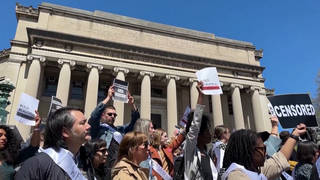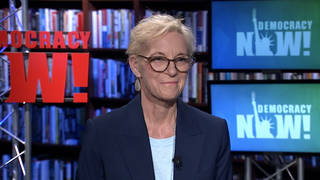
Related
We speak with one of the leaders of a new study that finds one in five reptiles are threatened by extinction. The results of the first comprehensive study of over 10,000 reptile species around the world were just published in the journal Nature and found multiple causes, including deforestation, urban encroachment, hunting and the climate crisis. “The fate of reptiles is wrapped up with the fate of many other species,” notes Bruce Young, the chief zoologist and senior conservation scientist for the wildlife conservation group NatureServe.
Transcript
AMY GOODMAN: We turn now to continue to look at climate change but at how a devastating new report finds that one in five reptiles are threatened by extinction, with turtles and half of all crocodile species most at risk. That’s the conclusion of the first comprehensive study of over 10,000 reptile species around the world, that took nearly a thousand scientists and 15 years to complete. The study was just published in the journal Nature, found multiple factors are threatening reptiles, including deforestation, urban encroachment, hunting and the climate emergency. This is environmental biologist Leslie Rissler with the National Science Foundation.
LESLIE RISSLER: Species are declining at a rapid rate. Some estimates 10 times, 100 times, 1000 times more than the background rate of extinction that normally happens on the planet, so we’re at a really critical time in our — you know, in Earth’s history.
AMY GOODMAN: For more, we’re joined in San José, Costa Rica, by Bruce Young, co-leader of the new study assessing the global extinction risk of reptiles, chief zoologist and senior conservation scientist for NatureServe.
Welcome to Democracy Now! It’s great to have you with us, Dr. Young. If you can start off by talking about what surprised you most about the results of this study?
BRUCE YOUNG: Well, thank you for having me.
Yeah, so, you’ve described the major results. It was a long time in coming, as you described. For me, I was expecting reptiles would be somehow different than many of the other groups that we had already studied. I mean, the history here, or the context, is that we had finished assessing the world’s birds in the 1990s. I participated in completing the global amphibian assessment in 2003. The mammals were done by 2008. And we just took a long time getting the reptiles done for a variety of reasons. And the whole time we were sort of nervous that with all this information on birds, mammals and amphibians, that was driving lots of priority setting in the conservation world, that reptiles were being left out, that we know that reptiles are unusually diverse in desert areas compared to other species, and we just worried that they were really falling through the conservation cracks. So what surprised me of our results is when we looked at the proportions of species that were subject to the different threats, they’re actually the exact same threats almost as birds, mammals and amphibians. And so, there’s nothing new about what you need to do to protect reptiles.
The other surprising finding we found is around this term called surrogacy. It’s something that conservation planners use. Because we don’t have information on all species — there’s millions of species out there — we use the species we do have information about to set our priorities for conservation. And we hope that the species that we’re working on are good surrogates for these other species. And what we found was that birds, mammals and amphibians actually serve as good conservation surrogates for threatened amphibians — threatened reptiles, excuse me. So that means if you do your prioritization based on those three groups, which we’ve had information for for more than a decade, you’re actually going to take care of a lot of the diversity of threatened reptiles. So that’s kind of good news, in a sense, that there isn’t this whole new category of conservation that we need to address today.
AMY GOODMAN: So, if nothing is done to conserve reptiles, can you talk about, overall, what’s happening to global ecosystems? How much time do we have to try to mend the loss of over 20% of reptiles on Earth?
BRUCE YOUNG: Yeah. Like I said, the fate of reptiles is wrapped up with the fate of many other species. I mean, I can’t give any numbers in terms of how many years we have. What we found is that reptiles are actually the most diverse numerically in tropical rainforests. Again, that should sound familiar. We know that birds, mammals and amphibians are also very diverse in tropical rainforests. So, when you hear about continued deforestation in the Amazon, for example, that means we’re losing reptile species there, just like we’re losing other species. And it’s causing that problem with climate change due to the loss of all that stored carbon in the forests there.
AMY GOODMAN: You talk about multiple factors: deforestation, urban encroachment, hunting, the climate emergency. You’re in Costa Rica in Central America, which has historically been the site, the whole region, for extractive projects like mines and hydroelectric dams. How have these industries, largely funded by multinationals, affected or contributed to the crisis?
BRUCE YOUNG: Well, here in Costa Rica, it’s a bit different than elsewhere. We don’t have many minerals here. And in fact, it goes back to the whole history of Costa Rica. There was never gold found here, so it was a very different kind of people that settled, Europeans that settled Costa Rica, compared to the other countries.
We do have a tremendous amount of hydropower. But, I mean, from a climate perspective, that’s a good thing. In Costa Rica, 99% of our electricity is generated from renewables, principally hydropower. These are financed through international financing mechanisms and carried out by the Costa Rican Electricity Corporation, which is a nationalized firm. These hydro projects do have a negative effect on the environment, no doubt about it. River systems are changed. The flows and all that kind of thing are heavily impacted.
For reptiles, it’s not a big thing, because there are almost no reptiles that inhabit these rivers that come off of the mountains. There’s crocodiles where these rivers come out to the ocean, but they’re not affected by those dams. So, in fact, reptiles are relatively unaffected compared to many invertebrates, otters and things like, that that live in the rivers themselves.
AMY GOODMAN: As we wrap up, Dr. Young, can you talk about the U.N. Convention on Biological Diversity, what makes it so important? The U.N. Biodiversity Conference is coming up in Kunming, China, in October.
BRUCE YOUNG: Well, our study reminds us of what’s riding on this convention. You know, we just described 1,800 species of reptiles that are threatened with extinction. That’s a small part of the 40,000 species that the IUCN Red List lists as endangered with extinction across the globe. That’s a tremendous part of our biodiversity, our national heritage, is riding on the success of those negotiations. So this is a big moment.
For the last 10 years, we were under the Aichi targets that were set in the year 2010 under the Convention on Biological Diversity. They expired in 2020. And since then, there’s been the negotiation for the so-called post-2020 framework. What we learned from the Aichi target experience is that even though governments set those targets, there wasn’t much kind of implementation of conservation measures. And in fact, when we looked at it, almost none of those targets were reached.
So, this time, for this post-2020 framework, we’re hoping for real targets with real mechanisms that hold countries accountable for achieving those targets. So, as I say, there’s a lot riding on these discussions and negotiations that are due to come to head at COP15 in Kunming.
AMY GOODMAN: Bruce Young, I want to thank you for being with us, co-leader of the new study assessing the global extinction risk of reptiles, chief zoologist and senior conservation scientist for NatureServe, speaking to us from Costa Rica.
Next up, we get an update on Ukraine from Jan Egeland, the secretary general of the Norwegian Refugee Council, just back from Ukraine. Stay with us.










Media Options